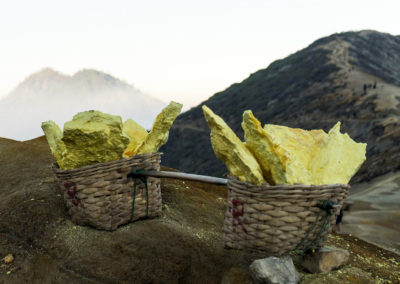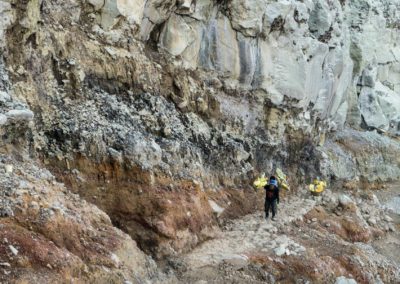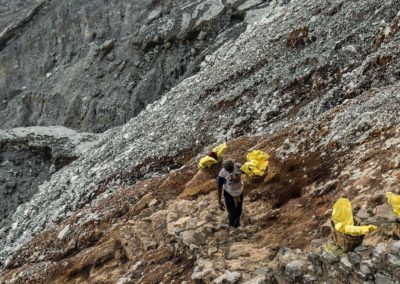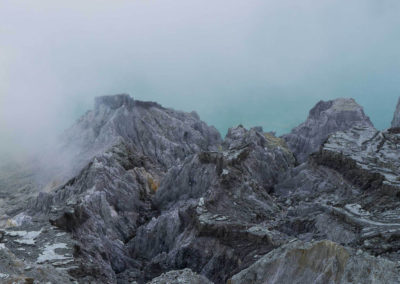The Green Crater
In the heart of the Pacific Ring of Fire, Mount Kawah Ijen (meaning « green crater » in Javanese), reveals a majestic giant who is unlike any other. A natural wonder offering a spectacular show and the flaming belly of hell for the porters of sulphur who venture into the mouth of the ogre to extract the precious ore. A scene from another era that is reminiscent of the strength of our land and the madness of our humanity, as described by the famous photojournalist Sebastio Salgodo when he exposes his work on gold mining in Papua.
To this effect the « trek » of Kawah Ijen is out of the ordinary because it questions the place of tourism beyond the interest of the volcano. Every day, at nightfall, tourists flock to admire the phenomenon of « blue fire ». Blue flames burn the surface of the most acidic lake in the world! On the way, we will meet a hundred or so porters, some proud to face the giant, others weakened by the years spent extracting the ore. These men show incredible courage by harvesting the sulphur that they carry every day over nearly twenty kilometers. The famous « green crater » is the largest open-air sulphur reserve in the world, with nearly 36 million cubic meters. This « eldorado » in appearance is not exploited directly by an industrialist because of its dangerousness. The volcano, when it wakes, projects extremely toxic sulphur fumes and acid up to 600 meters up in the air !

It is in the calm of dawn that we begin our ascent of the crater. A kind of rhythmical and jerky clicking surprises us. The mystery clears up very quickly on the way: sulphur porters are already at work. They have begun the descent of the twenty kilometres separating them from the Licin treatment plant. On their shoulders they balance large blocks of sulphur, distributed in two woven bamboo baskets connected by a pendulum. The deformation of the ensemble is at the origin of this characteristic noise. Above, near a wooden cabin, the porters arrive and hasten to weigh their load, which can reach nearly 100kg for the youngest! The eldest still manage to carry a good fifty kilos…
As we arrive at the edge of the crater, at over 2300 meters above sea level, the rays of the sun reveal the heart of the monster. At the bottom, the crater’s lake reveals a magnificent emerald green colour. The surprising landscape and the acidic composition of the lake offer a stunning view. Abundant fumaroles indicate the location of the exploitation of sulphur. Here, the soil is yellow. But, over the course of the wind, this bright colour disappears ceaselessly in the sulphurous gray fumes that lick the gullies of the crater. Breathing is difficult or impossible when approaching the extraction zone. Necessitating sometimes a long apnoea between two puffs of more breathable air. In the lair of the volcano, we discover a scene from another age as means of extraction are rudimentary. Workers cannot always afford gas masks to protect themselves and often use a simple cloth over their mouths. The orange-coloured liquid sulphur is channelled through pipes as soon as it is discharged. The workers cut loose pieces of cooled rocks which they break using simple miner’s picks.
Here we are in contact with a community, that of the porters of Kawah Ijen, which has about 200 workers. These men can extract a total of 6 tons of sulphur per day for a salary of about €150 ($180) per month. For most of them this work is their only means of subsistence to support their families. These hard workers have a life expectancy of about 50 years. Despite their hard work, they are not slaves. A feeling of pride is very often seen on the faces of these conquerors who defy the monster Kawah Ijen every night. The sulphur will be used in various ways. It will help treat joint disease, participate in liver detoxification or act as an anti-inflammatory or antioxidant …
A glimpse …
Copyright – © Mandara
Other articles you may enjoy…
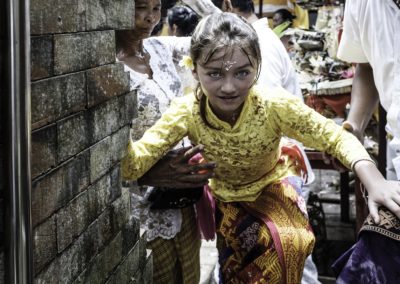
The journey of Anna Livia
Découvrez Bali au travers du photographe Antoine Barrières, que nous eu le plaisir d'accueillir sur l'île des Dieux avec sa petite ... Liez plus
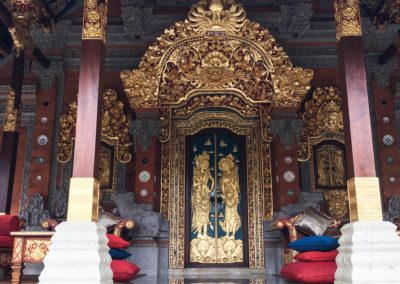
L’architecture royale
Bali, l'île des dieux, est une destination surprenante. Les premières fois où je me suis balader au coeur de l'île, c'est ... Liez plus

